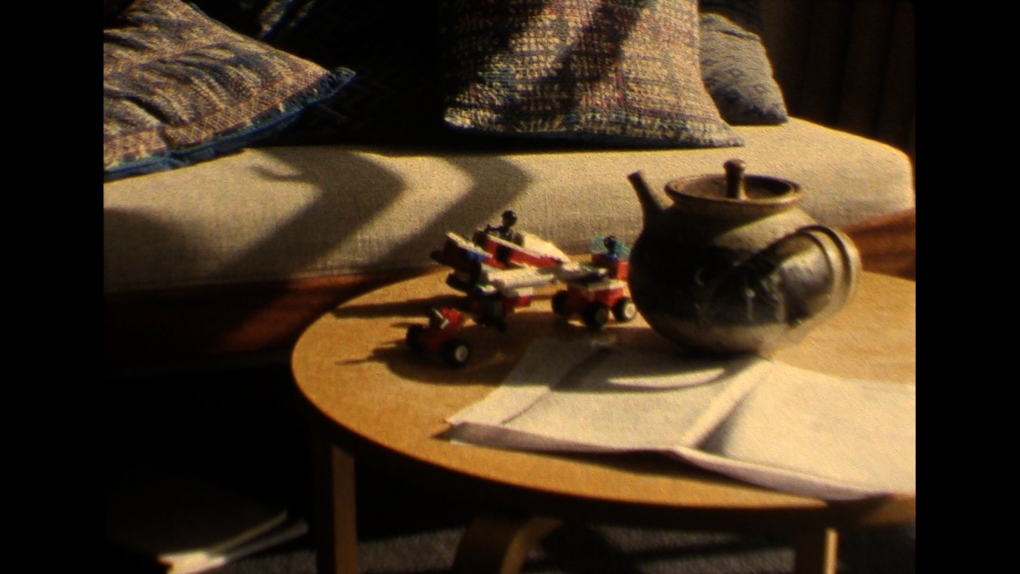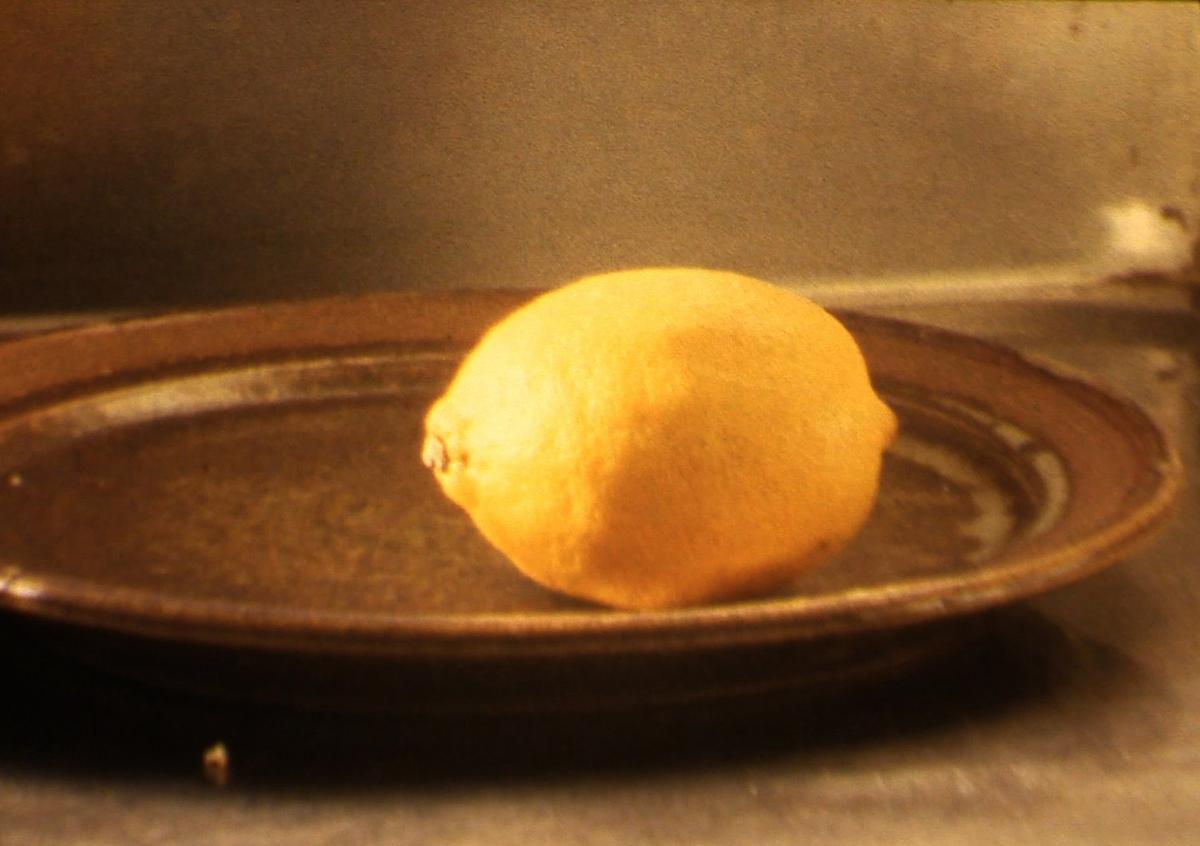Through the shaped spaces of the
bed's frame; through the flower
carved in wood & through the
window pane; through the pierced
verandah hood, the foliate rose I
see the straight & curved branches
parting of a tree.
Without the lens
heaven, /the heavens less understood.
The throughness of things, where objects once familiar, become strange, is a concept threaded throughout the multidisciplinary artwork of Joanna Margaret Paul. It is sketched in her restrained, abstract drawings of everyday objects; printed into her colour drenched photographs that fragment fleeting moments and cracks light into the sleepy surroundings of her rural domicile; in her poetry that is framed so sparsely that the spaces between letter pressed text reveal a graceful, emotional labyrinth; and in her remarkable body of experimental film work where gusts of wind and fleeting light can turn napkins hanging on a clothing line into a love song. What was once tactile becomes untouchable, transmuted with a lens into the shadows of a theatre. Everything becomes a frame, a distant open window that is persistently out of reach.
‘Through the shaped spaces...’ is the opening text in Like Love Poems, an anthology published shortly after her tragic, early death in 2003. The above poem expresses a dilemma. Without the lens of art, there is unframed life, in all its wondrous absurdity. With the lens, be it a book, a camera frame or the blank canvas of a sketch pad, an artist can comprehend, transmute and touch this mystery. The interconnectedness of things expands through the interconnectedness of themes found throughout Paul’s interdisciplinary practice. There is a sense of necessity and sacrifice throughout her work, as Paul avoided the trappings of careerism, and manoeuvred around the restrictions imposed by her poverty. There is a celebration and recontextualisation in her rural existence, a documentation of the emotional flux of light and time into art works that can stand still, be archived, replayed, or projected ad infinitum.
For this commission project myself and co-curator Mark Williams invited six artists to create new moving image works, providing a selection of Paul’s poetry as a point of inspiration. As curators, we placed particular emphasis on work which was often seen as ancillary to her studio practice, as Paul was better known for her painting and drawing than her film or poetry. Recently however, her celluloid work is being celebrated and rediscovered by scholars, curators and artists from across the globe. Seemingly created in isolation from experimental film communities in the US and Europe, Paul’s films have a paced, original poetic sensibility that was practically unknown outside of New Zealand. Paul’s films bear a similarity to experimental 8mm first person works like Stan Brakhage’s Songs cycle (1964-1969), yet lack the self-mythologising and epic undertones. Paul’s throughness of things, is often articulated and filmed as a list, an index that in her films, like in her poetry, documents her surroundings; once familiar, now strange: meditations on blue
sudden spears of
Agapanthus open
blue on grey
Pohutukawa
with the violence of
love in a
quiet life
There is a similarity in form in Paul’s celluloid work (often shot on 8mm film cameras for ease of access and affordability) and her poetry. Though much remains unpublished, the few works printed during her lifetime were collaborations with small printing houses who specialised in limited edition artist books. Within these book works, the typography printed using artisanal hand-operated letterpresses has a cinema-like resonance in their analogue textures. They were produced using hand-operated machines, clinking like the gears of a camera, or the rolling buzz of a projector. The pages contain a weighted inertia, an embedded grain that recalls the fleeting, weathered textures of her (now faded) original reversal celluloid prints. It is also Paul’s meticulous layout and design of the printed matter that resembles her films. The text arranged in her award winning, debut chapbook Imogen is sparse and fragmented, much like the quick in-camera edits and shadowed homespaces in Napkins (1975) and Aberharts House (1976). Her artist book Unwrapping the Body contains collages, drawings, photoworks and hand-written poems that suggest how Paul intended to combine the various facets of her multidisciplinary practice. The book has a hand-made, diaristic aesthetic. It contains a form of montage that mirrors her 16mm and 8mm sketches – unabashedly amateur, gestural, instinctual, and familiar. They frame the domestic as a space where mysticism can emerge from subtle, quiet reflection.
Aberhart's House (1976) Joanna Margaret Paul
Celebrating a renewed interest in her rarely screened film works, we proposed to not restrict ourselves to presenting a retrospective screening, but rather, a conversation of sorts with contemporary New Zealand media artists. A new body of work was created, not as a homage, but to continue Paul’s explorations that were tragically truncated with her untimely death. By providing each artist with a unique selection of poetry, a diverse set of films were consequently created, faithful to the creative trajectories in their individual practices, but also leaving a trace of the themes, motifs and emotions found in the text provided.
Rachel Shearer’s I am an open window contains a stoic duration filmed in lush super 8mm textures. Tonal shifts are layered with text fragments gleaned from two of Paul’s poems provided to the artist. A lens is locked onto a persistent gaze of an open doorway, a cracked window, perhaps referencing Paul’s Barry’s Bay photographic series, where the lush foliage beaming from an open window is shrouded in the darkness of the surrounding interior. The super 8mm film stock is painterly, fragile and heavily textured. The work reinvents the aesthetics and form of small gauge cine-poems.
Sonya Lacey’s By Sea, literally uses language sculpted into an architectural form to create a remarkable dreamlike monochrome landscape. The film was shot inside a cast salt model of the letters that form Par Mer. Her voice-over follows an abstract narrative, whispered as a disembodied floating camera slides along mirrored surfaces. Referencing the inside/outside dichotomy repeated through much of Paul’s work, Lacey appropriates field notes from NASA’s Tektite, semi-autonomous underwater lab experiments to emphasis this either/or division of space. The film is interspersed with microscopic filming of salt crystals, pans of cracks, layered salt textures, and projected textural images. Lacey hints to the precariousness of living in a bubble, and the permeability that exists between intimate interiors, and the emotional breaches that can occur.
Still Light by Ngāpuhi artist Nova Paul is a fluid, patient use of duration and the camera frame. Everyday life is sculpted into fleeting shadowed moments in abandoned spaces that are without physical human presence. The soft 16mm celluloid colour palette is melancholic yet soothing, and presence is reflected, transformed into the silent gaze of inanimate objects. This beautifully paced film makes the silence sing, the objects and plant life that surround the frame come to life. It is at once a self-portrait and a homage to the mirror of contemplative cinema.

A still from Still Light (2015) Nova Paul
The collective Popular Production’s third revision is an essay film shot over a decade in Warsaw, Berlin and New Zealand. A travelogue, diary film and philosophical treatise, the work pieces together a remarkable montage of personal notes, footage from prisons and public housing, drawings and animated sculptures. Filmed text is distributed throughout the work, in handwritten notes and scrolling down a computer monitor. Layers of ideas, video texture and experimental, concrete soundscapes present a playful conceptual wordplay that is in itself poetic.
Sky by Miranda Parkes uses the video camera as a drawing tool. The work, one of five created for the project by the artist, situates the camera in a bed of grass. The vision/drawing machine records light and sky; fleeting clouds turn the heavens into a quilted flat canvas of light and time.
-Miranda-Parkes_CIRCUIT.jpg)
Still from Sky (2015) Miranda Parkes
Finally, Ngāti Tūwharetoa artist Shannon Te Ao’s Untitled (Epilogue) gleans elements from Paul’s past work, specifically, a collaboration with Noeline Arnott, in which Paul provided drawings for her short story Relics from an ancient tomb (1986). Reading from this text, Te Ao slides a camera past a series of darkly lit potted plants, taken from the Katherine Mansfield house in Wellington. Melancholic and meditative, the film embodies the restrained ache and duress found in some of these authors’ writings. As the camera glides repeatedly past pots of domesticated foliage, tonal noise eventually overtakes the voiceover, an overflowing of wordless emotion, and a blissful abstraction that could reference the final blank page in a book of poetry. All the commissioned works display a remarkable diversity in scope and form. By reframing Paul’s cinema with new films, we hoped that an archive could be brought to life; speaking, breathing and collaborating to create new context for contemporary media arts practices. A new lens is formed, and a certain sense of poetic necessity emerges.
-Shannon-Te-Ao_CIRCUIT.jpg)
Still from Untitled (epilogue) (2015) Shannon Te Ao
